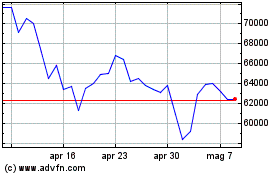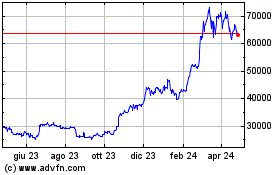Analyst Reveals Bitcoin’s Halving Cycle Signals Untapped Potential—What’s Next?
18 Febbraio 2025 - 10:30PM
NEWSBTC
Bitcoin’s price performance in recent weeks has maintained a
sluggish movement, with the cryptocurrency now hovering near the
$97,000 mark. Despite the 3% decline over the past two weeks,
Bitcoin remains within a consolidation phase following its January
all-time high above $109,000. As the asset lingers in this range,
discussions around the ongoing halving cycle and its potential
impact on future price movements have gained momentum. One
noteworthy perspective comes from CryptoQuant analyst Oinonen, who
recently shared insights into Bitcoin’s current standing relative
to past halving cycles. Related Reading: Bitcoin’s Realized Cap
Hits Record High—Is a Major Bull Run Brewing? Institutional
Activity and Market Signals In a detailed analysis titled
“Comparing Post-Halving Performance,” Oinonen pointed out that
Bitcoin’s price has only risen 63% since the most recent halving in
April 2024. This contrasts sharply with the 686% surge seen in the
halving cycle of 2020-2021. While the power-law model and the
principle of diminishing returns suggest more subdued gains over
time, the relatively modest appreciation since the last halving
indicates that the current cycle may still be in progress, leaving
room for further upside. Oinonen also highlighted the role of
institutional players in shaping Bitcoin’s price outlook. Notably,
Strategy (formerly MicroStrategy) continues to be an influential
market participant. In early 2025, the company increased its
Bitcoin holdings by 7,633 BTC, bringing its total to roughly
478,740 units. According to Oinonen, Strategy’s ongoing acquisition
strategy is a key indicator of institutional demand. Historically,
these purchases have been pro-cyclical, suggesting that continued
accumulation could signal a positive trajectory for Bitcoin’s spot
price. Conversely, a slowdown in institutional buying could reflect
a weaker market sentiment. Long-Term Outlook Amid Unfinished
Halving Cycle Looking ahead, Oinonen anticipates a mixed market
environment. Short-term challenges, such as a potential “sell in
May” effect and a stagnant summer, may give way to stronger
performance in the fourth quarter. The analyst reveals that this
seasonal pattern has played out repeatedly in previous years, often
resulting in elevated price levels by year’s end. However, the
possibility of a more significant correction—spanning several
months or even a year—remains on the table, particularly if
macroeconomic events, such as geopolitical resolutions, shift
market dynamics. Overall, the current halving cycle, by Oinonen’s
analysis, appears incomplete. The moderate gains since April 2024
reflect a market that has yet to fully capitalize on the reduced
issuance rate. Related Reading: Bitcoin STH Realized Profit Reveals
Strong Support Level – Time For A Breakout? As such, the notion
that Bitcoin’s bull run might still have legs is underpinned by
historical trends and the presence of institutional players like
Strategy. The interplay between reduced supply and continued demand
sets the stage for potential upward movements, even as near-term
volatility persists. Featured image created with DALL-E, Chart from
TradingView
Grafico Azioni Bitcoin (COIN:BTCUSD)
Storico
Da Gen 2025 a Feb 2025

Grafico Azioni Bitcoin (COIN:BTCUSD)
Storico
Da Feb 2024 a Feb 2025
